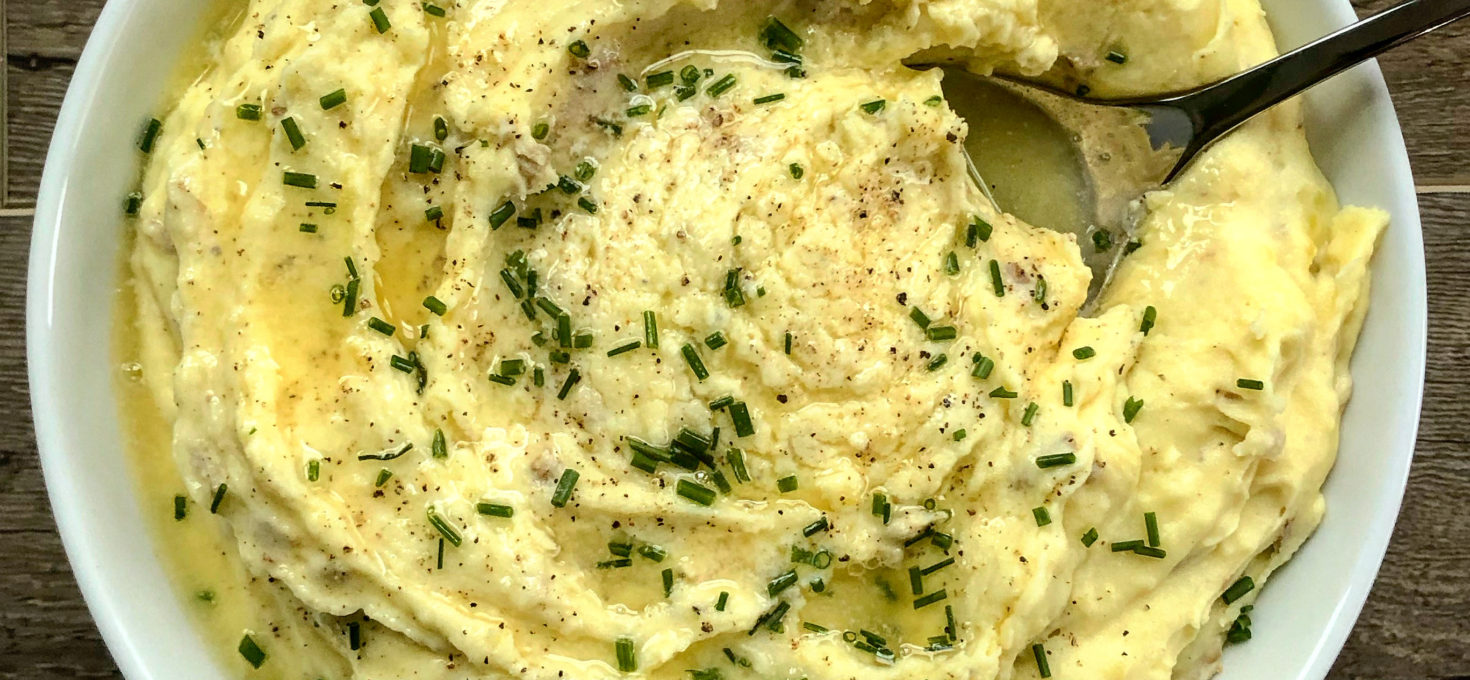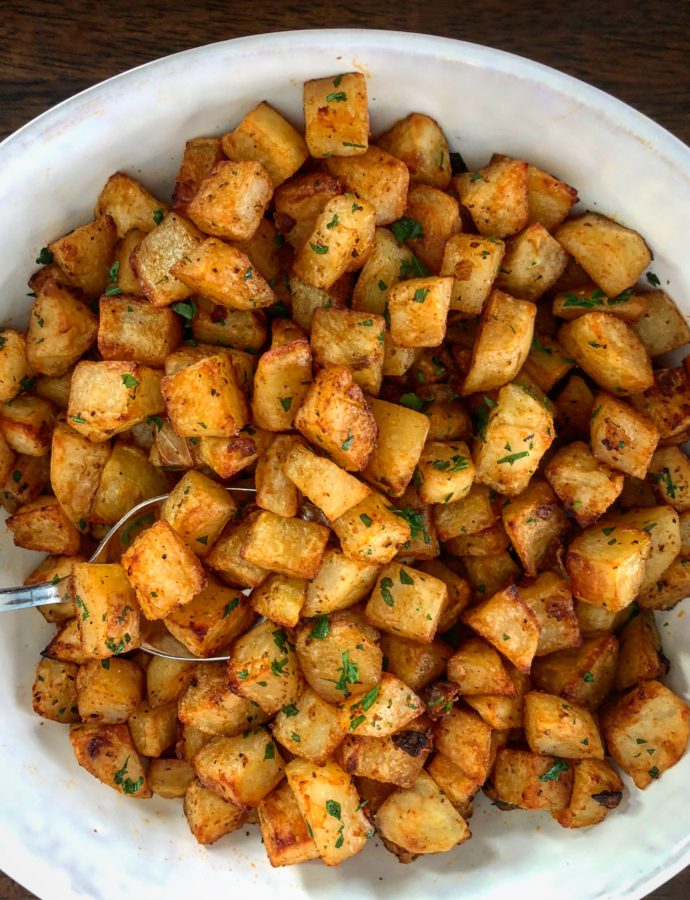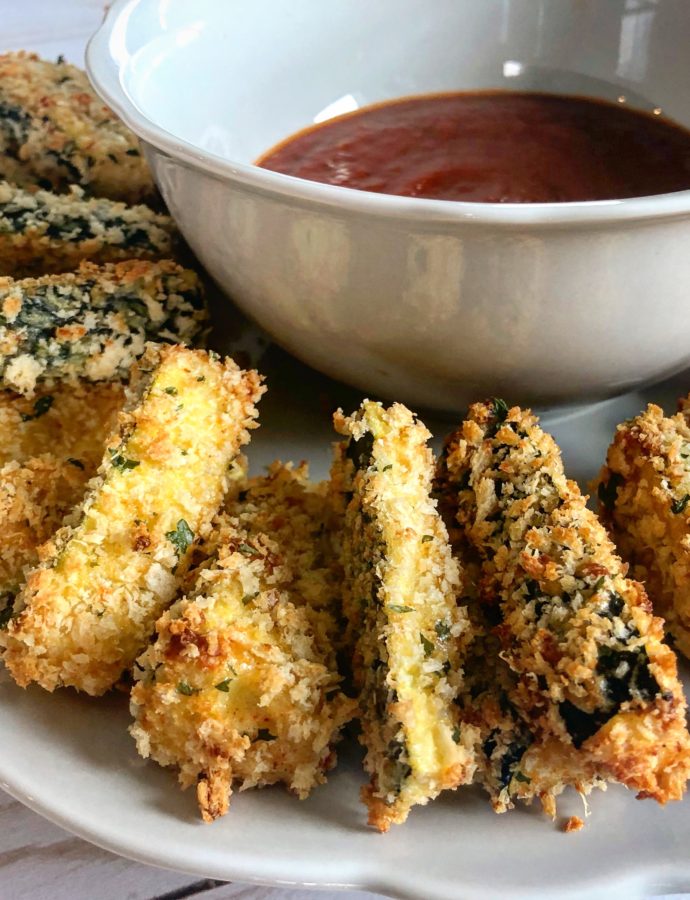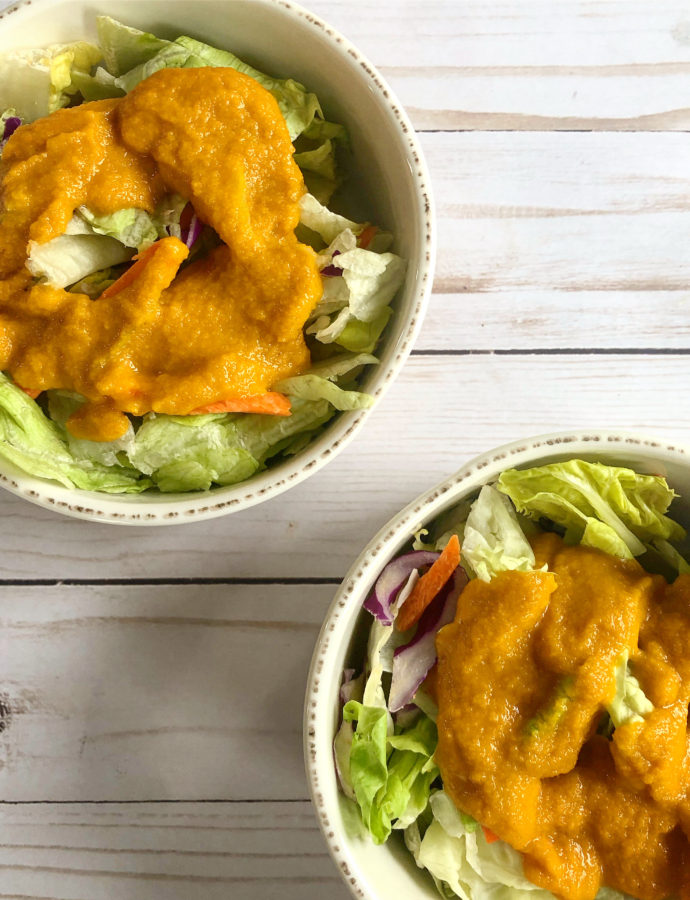Did you know that there is a science to getting delicious tasting mashed potatoes? I mean, it’s not rocket science, but nonetheless, there are definitely things that you should and should NOT be doing to get the most out of your taters. See, sometimes the things with the shortest ingredient list can be the trickiest things to make. That was how I felt about biscuits for the longest time. So in those cases, it’s less about quantity and more about quality (and how you treat those few ingredients). These Simplest Mashed Potatoes are exactly that- a few ingredients done right.

For almost all of my recipes, I offer step by step instructions with pictures. Maybe you read through them and maybe you don’t it completely necessary. I totally get skipping through, not offended at all (quietly sobbing into pillow). I kid, I kid. Anyway, I would really recommend reading through this recipe’s instructions. Below, I will leave my tips and tricks of achieving the ultimate creamy texture. I’ll also show you things you should and should NOT do when cooking mashed potatoes. So let’s get started.
Let me show you how I made The Simplest Mashed Potatoes 👇🏻
Let’s Talk Taters:
First let’s talk about what potatoes make the best mashed potatoes. There are basically 3 kinds of potatoes: Very starchy ones like Russets, very waxy ones like red potatoes, and potatoes that are “in between” like gold potatoes. You don’t want to use waxy potatoes for mashed potatoes so keep those reds for roasting. The creamiest mashed potatoes are made from Russets, but golds will work really well as well. I personally prefer the flavor and color of the golds. I also really enjoy the skins of the gold potatoes- no need to peel.
Washing the Potatoes:
You need to thoroughly wash your potatoes. Duh, right? You might be surprised to find out that some people figure that by throwing the potatoes into a pot of boiling water means that they don’t need washed. Wrong. Potatoes are very dirty. And any time, you have to slice a knife through a food item, you will be dragging any dirt (or whatever) down through the flesh of said item. So wash them throughly.
Cutting the Potatoes:
Now that your potatoes are washed, we’re going to cut them. If you can avoid not cutting potatoes before boiling, sure, don’t cut them. But here’s the deal- in order to avoid cutting your potatoes, all of the potatoes need to be extremely similar in size. Below are 2 potatoes from the 3 Lbs that I am using to make my mashed potatoes. If I left these uncut and threw them in the water, they would cook extremely unevenly.

You want to cut your potatoes so they are even in size. I usually go for a 1.5-2” cubed potato. It is large enough that they won’t fall apart and small enough that they wont take 40 minutes to cook. Personally, I have never had an issue with cut potatoes becoming “water-logged“ after boiling them. Potatoes cut to this size are only going to take about 20-25 minutes to cook to fork-tenderness.

Let’s Talk about Cooking Water:
You want to place the cut potatoes into a large, EMPTY pot. Then, you want to cover the potatoes with cold water. Fill the pot so that there is an inch or two of water above the potatoes. You never want to place potatoes into boiling water. Putting potatoes into boiling water will cause them to cook unevenly, the outside will overcook and the insides will be undercooked. When cooking potatoes, you want to heat up the potatoes and the water at the same time, hence the cold water.
Also, salt the water. Throw in a good-sized pinch of salt and stir.

Cooking the Potatoes:
Bring the potatoes to a boil over high heat. AND THEN lower the heat to medium-high or medium heat so that the potatoes are simmering. If you boil the heck out of your potatoes, they will fall apart. So be a little gentle with them.
While the Potatoes are Cooking:
Okay, so the potatoes are cooking. Now what? Well, when the potatoes are done, we are going to be adding butter and cream to them. If the butter and cream are cold, what do you think will happen to the temperature and texture of the potatoes? You guessed it. You never want to add cold dairy to potatoes, it will cause the potatoes to become gluey. Heat the heavy cream in a sauce pot over medium or medium-low heat until warmed.
Let’s Talk Butter:
Your butter should be softened, not melted. When butter is melted, the milk solids and fat separates and you don’t want that. You want everything to melt and distribute evenly. I choose to use unsalted butter for mashed potatoes. Personally, I like to be able to control the amount of salt being put into them. However, you could also use salted butter as well- just watch the extra salt that you are adding at the end.
You want to add the butter to the potatoes first because there is a more water content in the heavy cream. Adding the butter first will coat the starches in the potatoes and your potatoes will be creamier for it.

What Tools Should I Use?
In this recipe, the end-goal is creamy, silky mashed potatoes. So to achieve this goal, I use a hand mixer. You might be able to get a creamy mashed potato by using a masher, but it’s going to take a lot longer than a hand mixer and, at that point, you’re probably going to be worrying about your potatoes staying warm. So use a hand mixer. It’s easier and faster. Mix on low, increasing speed to high. Beat until the potatoes are smooth. Then lower the speed to low and slowly pour in the warmed heavy cream. I typically use about 1.5 cups. The amount you use will be based on your preference.

Beat It, Just Beat It
Beat the potatoes with the hand mixer for a few minutes. You may even want to take a rubber spatula to scrape the bottom and edges of the pot to make sure that there are no large lumps. You want to beat the potatoes until they are light and fluffy.
Season ‘Em Up
Last and final step is seasoning. Make sure that you use a good amount of salt and black pepper. I’ve never actually measured the amount that I use, and really, the amount is more based on preference. But with so few ingredients, you definitely need to make sure that your seasoning is on point. So season, taste, and season more if necessary.
Mix-Ins
With mashed potatoes, there are so many wonderful ingredients that you can mix-in. There are you dairy options- like sour cream, cream cheese, or cheese. As far as cheeses go, my favorites are parmesan, Gouda, and cheddar. There are really no bad options as far as cheeses go. And then there are other mix-ins like bacon, chives or green onion. Sometimes I like to switch it up and add some of these mix-ins; it usually depends on what the entree is that I am serving with these potatoes.

Honestly and truly, I have found that 9 times out of 10, I prefer these mashed potatoes as is- perfectly simple and perfectly delicious. I usually drizzle a little melted butter over the top. In the pic below, I also added some chopped chives (mostly just for color, but they can be a nice addition).

Tip on Keeping Mashed Potatoes Warm
If you need mashed potatoes to keep warm while you’re finishing up other things, the best way to keep them warm is in a double boiler. Fill a pot with water. Place your mashed potatoes into a glass bowl (or any other heat-proof bowl, not plastic) and set the bowl onto the pot. The water should be at a very gentle simmer, heat set to low, and the bowl with the mashed potatoes should not be touching the water. You want the steam from the water to keep the mashed potatoes warm. The gentle heat will keep them warm without drying them out. Stir occasionally with a silicone spatula. Add a little more melted butter or heavy cream if necessary to loosen them up before serving.
Enjoy!!
These are the recommended products that I used to make this delicious recipe. These are not only products that I use, but products that I love.






The Simplest Mashed Potatoes
Ingredients
- 3 Lbs Yukon Gold Potatoes
- 1 1/2 Cups Softened Unsalted Butter (3 sticks)
- 1 1/2 Cups Heavy Cream, warmed
- Salt & Pepper
- Chopped Chives + Melted Butter, for serving
Instructions
- Thoroughly wash potatoes. Cut them into 1.5-2” chunks and place into a large empty pot.
- Fill the pot with cold water so that there is 1-2” of water above the potatoes. Turn the heat onto high and add a good-sized pinch of salt tp the water.
- Bring the water to a boil and then lower the heat to medium-high so that the water is at a medium simmer. Cook the potatoes until they are fork-tender, about 20-25 minutes.
- While the potatoes are cooking, gently warm the heavy cream. You can heat in 15-30 second increments in the microwave or heat in a sauce pot over medium-low until warmed.
- When the potatoes are fork-tender, drain them in a colander and then place the potatoes back into the hot, large pot. Let the potatoes dry out for a minute and then add the softened butter.
- Using a hand mixer, beat the potatoes on medium-high speed until they are smooth. Lower the beating speed to low and slowly pour in the warmed heavy cream until the potatoes reach your desired creaminess.
- Add a generous amount of salt and pepper to the mashed potatoes. Start with 1/2 tbsp, taste, and add more if necessary.
- Serve the mashed potatoes topped with melted butter and chopped chives. Enjoy!









 Welcome to Cupcakes and Sarcasm! My name is Maggie and I am the creator of C & S. I am a wife and mom of two beautiful kiddos. I grew up in Columbus, Ohio and now live in Northeast Ohio with my family. I have been cooking and baking since I was a kid. I decided in 2017 that I wanted to share my passion (and recipes) with all of you! On this site, you’ll find easy and delicious recipes- both savory and sweet. I’ll also sprinkle in some stories of parenting and our adventures along the way.
Welcome to Cupcakes and Sarcasm! My name is Maggie and I am the creator of C & S. I am a wife and mom of two beautiful kiddos. I grew up in Columbus, Ohio and now live in Northeast Ohio with my family. I have been cooking and baking since I was a kid. I decided in 2017 that I wanted to share my passion (and recipes) with all of you! On this site, you’ll find easy and delicious recipes- both savory and sweet. I’ll also sprinkle in some stories of parenting and our adventures along the way.